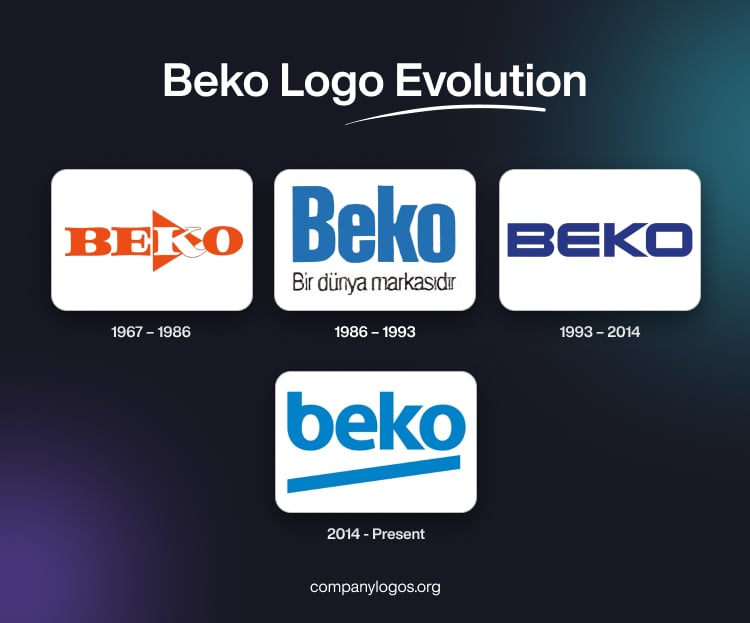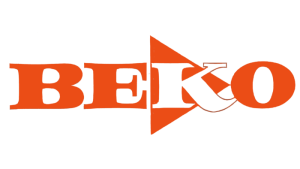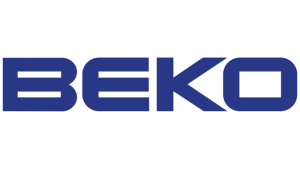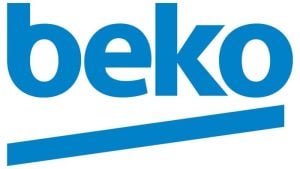
Beko is a Turkish brand under the Koç Holding conglomerate and was established in 1955 by Vehbi Koç and Leon Bejerano. The brand name is a combination of the first two letters of the founders’ surnames, Bejerano and Koç. Since its inception, Beko has grown into one of the leading names in home appliances and consumer electronics, and it has its footprints in more than 55 countries.
The Beko logo has changed quite a few times based on aspects such as adhering to the changing design aesthetics, increasing visual impact, and aligning with the vision of the company. Besides, the logo and its variants reflect the impactful journey of the company since its inception. The article delves into the various logo changes of Beko, among other details of the company.
(1967 – 1986)
The original Beko logo featured the brand name in a deep orange colour. The thick, wide letters had narrow, elongated serifs and small spaces between them. Also, the letter “K” in white set against an orange-coloured isosceles triangle touched the letter “O” in orange.

(1986 – 1993)
The logo evolved into a more contemporary look to reflect growing modernisation in technology and business. The brand name in the title case appeared in bold blue, and the stem of the letter “k” was similar to the height of the letter “B”. The heavy narrow letters of the brand name were written using a sans-serif typeface. Beneath the brand name was written the motto of the company in black, the length of which aligned with the length of the brand name.

(1993 – 2014)
During this era, the logo saw further refinement. It embraced a cleaner and more minimalistic typeface, with a deeper shade of blue remaining the dominant colour to evoke trust, calm, and reliability. The brand name in uppercase letters written using a wide sans-serif typeface with rounded outer angles became more uniform. It matched the global trends of the ’90s and early 2000s, when Beko was expanding into new international markets.

(2014 – Present)
In 2014, Beko underwent a significant rebranding and logo update. The new logo, developed by Sagi Haviv of the renowned design firm Chermayeff & Geismar & Haviv, marked a sharp departure from previous designs. For the first time, the logo in a light shade of blue used all-lowercase letters, which made the brand appear more approachable and modern.
A distinctive diagonal underline was added to convey a sense of energy and movement. This underline, often seen as a symbol of dynamism, became a recognisable element. Besides, the design team customised the letterforms, especially the letters ‘b’ and ‘o’, to achieve a more harmonious and visually appealing logo.

The Elements of the Beko Logo
Font
The Beko logotype is written using a modern sans-serif typeface similar to Quebec Serial Heavy and SST Heavy.
Colour
The colour palette of the Beko logotype is a light shade of blue, which evokes a professional approach to how goods are produced.
The History of Beko
Beko was founded in 1955 in Turkey by Vehbi Koç and Leon Bejerano. It is a part of Koç Holding, which is one of the country’s largest and most influential conglomerates. The company’s name was constituted by blending the surnames of its founders, that is, “Bej” from Bejerano and “Ko” from Koç. Beko initially focused on consumer appliances and entered the Turkish market when it was relatively new in Turkey.
During the 1960s and 1970s, Beko established itself as a leading domestic manufacturer of refrigerators, washing machines, and other household appliances. And in no time, the brand became known for its reliability and affordability. It filled a growing need for modern home appliances in Turkish households.
In the 1980s and 1990s, Beko began exporting products beyond Turkey and marked its debut on the international stage. The company invested in technological upgrades and expanded its product range to include advanced kitchen appliances, electronics, and air conditioners. In fact, the focus of Beko on efficiency and affordability made it appealing in various emerging markets.
Beko became part of Arçelik A.Ş. (the white goods division of Koç Holding), and it leveraged Arçelik’s R&D and manufacturing capabilities to grow internationally. The company began establishing subsidiaries and production facilities in strategic global locations, including Europe and beyond.
Beko made significant strides in the United Kingdom and other European markets during the early 2000s. It became one of the leading home appliance brands in the UK and expanded its presence elsewhere in Europe. The key to success in these markets was a strategy of competitive pricing, maintaining consistent quality, and adapting products to local consumer needs.
In the 2010s, Beko’s global profile rose rapidly, which was aided by strong marketing strategies and sponsorships. These included partnerships with FC Barcelona and the European basketball championships. The brand repositioned itself towards young, modern families and emphasised innovation, design, and energy efficiency. Beko has continued to invest in smart and environmentally friendly technologies. It won awards for energy efficiency and eco-design. The company has also been aggressive in forging international partnerships, such as its joint venture “Voltas Beko” in India.
By the mid-2020s, Beko was present in more than 140 countries and is recognised as one of the top appliance brands in Europe. The company is committed to sustainability, which is evident in its slogan “Respecting the World, Respected Worldwide” and ongoing efforts to reduce its environmental footprint.
Interesting Facts About Beko
- Beko is a global home appliances and consumer electronics brand based in Istanbul, Turkey. It is part of the Arçelik A.Ş. group, which is one of the largest appliance manufacturers in Europe.
- The company was established in 1955 by Vehbi Koç and Bejerano, with the brand name “Beko” derived from the first letters of their names.
- Beko products are sold in over 140 countries, which makes it one of the most widely recognised Turkish brands worldwide.
- In the United Kingdom, Beko is among the top-selling home appliance brands, which is known for offering affordable and reliable products.
- Beko has developed energy-efficient technologies such as HarvestFresh™, which uses light technology to preserve vitamins in fruits and vegetables for longer, and AquaTech® for water-efficient washing.
- Beko has been a major sponsor of FC Barcelona and Fenerbahçe Basketball Team.
- The company has received several Red Dot Design Awards and iF Design Awards for its innovative product designs.
- Beko was one of the first appliance brands to meet the European Union’s strict energy efficiency regulations for refrigerators and washing machines.
- Through its product lines, Beko promotes an “Eat Like a Pro” campaign to encourage healthier eating habits, especially for children. It does so by partnering with sports organisations and schools.
- Beko has consistently expanded its manufacturing facilities, including plants in Turkey, Romania, Russia, and Thailand, to meet growing global demand.
Finally
The Beko logo and its various iterations show how the brand evolved from a local Turkish startup to a prominent global brand. The most recent redesign of its logo embraces modern design language and targets a younger audience. It underscores Beko’s commitment to staying relevant and innovative in the competitive world of home appliances.